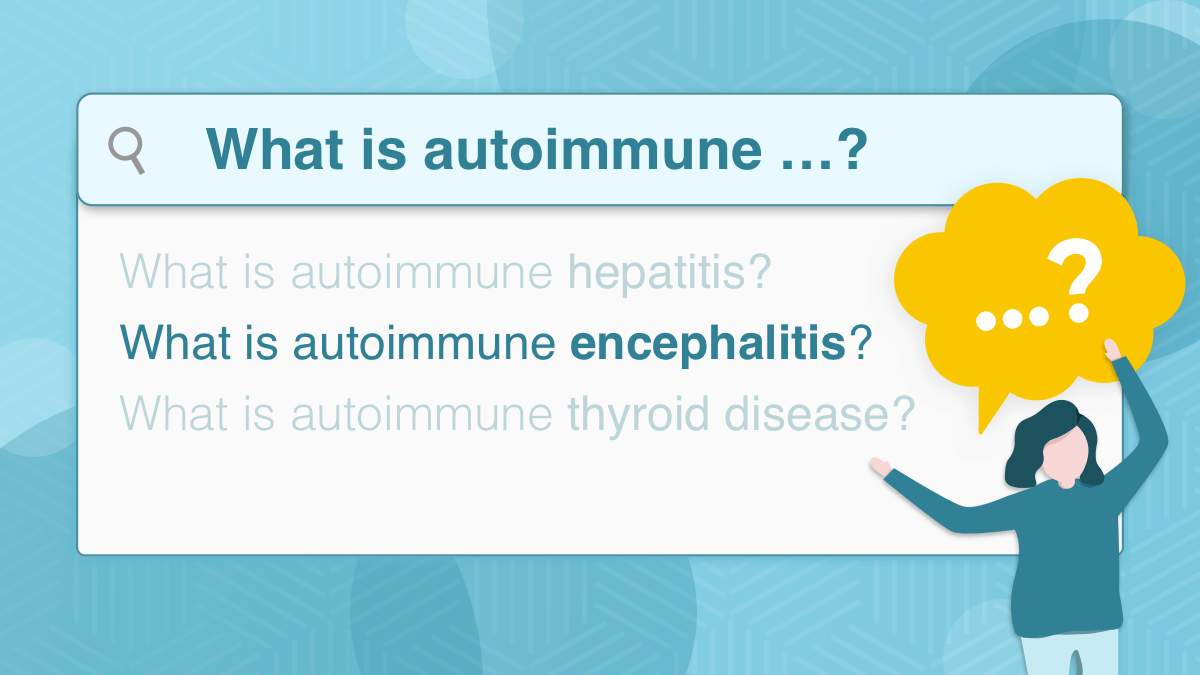Autoimmune diseases are complicated conditions. In this series, we take a look at three of the most commonly searched-for autoimmune diseases – autoimmune hepatitis, encephalitis, and thyroid disease – and explain the key points of each in simple, easy-to-understand language. In this article, we explain what autoimmune encephalitis is.
Other articles in this series:
- Autoimmune Diseases Explained: Autoimmune Hepatitis
- Autoimmune Diseases Explained: Autoimmune Thyroid Disease
What is an Autoimmune Disease?
The immune system is your body’s defense against from viruses and infections. When such invaders (pathogens) are detected, several immune responses kick into gear and aim to destroy them and keep your body healthy.
Antibodies are made to fight the pathogens.
In an individual living with an autoimmune disease, autoantibodies are produced and attack the body’s own tissue. The way in which it does so, and the specific tissue it targets, varies depending on which autoimmune disease one lives with.
In the case of rheumatoid arthritis, for example, the immune system attacks joints, leading to inflammation that results in swelling and pain.
Quite why the immune system attacks the body is not entirely understood. It seems genes play some role and individuals with a family history of autoimmune diseases may have a genetic disposition. In 2014, for example, researchers found a link between a mutation to a gene called ADAR1, which is involved in the body’s early response to foreign invaders, and autoimmune diseases such as lupus and motor neurone disease.
However, whether that disposition eventually results in developing a disease is not clear-cut.
It is widely believed that infections play a role in the actual development of a disease. Perhaps the best example of this is multiple sclerosis (MS), which causes the immune system to attack the fatty substance (myelin) surrounding the fibers of the central nerve system.
Viruses such as human herpesvirus 6 (HHV6) and Epstein-Barr virus (EBV) have been linked with MS. Most people are exposed to EBV during their lifetime but it usually symptomless. However, EBV can lead to another disease called mononucleosis (mono). Individuals who develop mono appear to be at an increased risk of MS.
However, while there does seem to be a connection between infections and autoimmune diseases, the cause and effect is not clear.
For now, most treatments for autoimmune diseases aims to control the immune responses and reduce inflammation, a common characteristic of autoimmune diseases.
What is Autoimmune Encephalitis?
The etymology of the word encephalitis combines the Greek word for brain: enkephalos with the -itis suffix, used for diseases that are characterized by inflammation. One can deduce, therefore, that the disease is defined by inflammation of the brain.
There are many different forms of encephalitis and it is often difficult to identify the cause, which can make treatment difficult.
Other posts you may be interested in on the MyTherapy blog:
- Christmas Disease: The Incredible Impact of Hemophilia B on European Royalty
- Type 1.5 Diabetes: Facts You Should Know About ‘The Other’ Form of Diabetes
The most common form is herpes simplex encephalitis, causes by herpes simplex viruses – type 1 and type 2 – that cause cold sores and genital herpes respectively. Other viruses, such as measles, mumps, and rubella may also develop into encephalitis, while other forms can be transmitted by animals such as mosquitos, ticks, and – in the case of rabies encephalitis – mammals.
Although autoimmune encephalitis has been referred to in medical literature for several decades, it was only in 2007 that the first specific antibody linked to the condition was identified by Dr. Josep Dalmua, when he described anti-NMDA receptor encephalitis.
It was this form of encephalitis that was the subject of a 2012 New York Times Bestselling autobiography by Susannah Cahalan, Brain on Fire: My Month of Madness. In it, Ms. Cahalan describes waking up in hospital with no memory of the proceeding month.
During that month, the then-24-year-old journalist had experienced psychosis, with symptoms including paranoia, violent episodes, and hallucinations. She had been diagnosed with schizoaffective disorder – when a person has features of both schizophrenia and a mood disorder such as depression or anxiety – before finally being diagnosed with auto-NMDA receptor encephalitis.
Once correctly diagnosed, a brain biopsy meant effective treatment was soon given and Ms. Cahalan gradually recovered.
Her story is perhaps typical of people living with auto-NMDA receptor encephalitis and highlights how difficult correctly diagnosing the condition can be. Dr. Souhel Najjar, who eventually diagnosed Ms. Cahalan, believes that up to 90% of people who lived with the condition in 2009 were undiagnosed. That percentage has likely dropped since then, but he believes some forms of schizophrenia, bipolar disorder, OCD, and depression may be caused by inflammatory conditions of the brain.
Abnormal behavior is particularly common in auto-NMDA receptor encephalitis, which occurs primarily in people under 45 years old. 80% of cases occur in females, over half of whom above 18 years of age have an ovarian teratoma (a tumor made up of different types of tissue).
Other forms of autoimmune encephalitis, which are defined by their autoantibody profile, are often linked to types of cancers and tumors. It means different parts of the brain can be affected, the severity and nature of symptoms is varied, and treatment options differ from patient to patient.
In 2016, the first widely-accepted diagnostic criteria for autoimmune encephalitis were defined.
Autoimmune encephalitis is considered a rare disease, with an incidence rate of 1.2 per 100,000 people per year between 2006 and 2015. However, this is probably an underestimation. Improved diagnostic methods and increased awareness will likely see the number increase in coming years.
Quick Facts About Autoimmune Encephalitis:
Autoimmune Encephalitis Symptoms
One of the reasons autoimmune encephalitis is difficult to diagnose is the wide range of symptoms, many of which mimic other disorders. Nonetheless, some of the more common symptoms are:
- Cognitive impairment
- Memory difficulties
- Seizures
- Involuntary movements
- Slowed or loss of ability to speak
- Behavioral changes
- Loss of inhibition
- Hallucinations
- Paranoid thoughts
- Severe anxiety
- Sleep disruption including severe insomnia
- Decreased level of consciousness – to the point of unresponsiveness, catatonia or coma
- Weakness or numbness of part of the body
- Loss of balance
- Vision changes
Autoimmune Encephalitis Treatment
According to the Autoimmune Encephalitis Alliance, there are four first-line treatments:
- Removal of a teratoma (if present) that could be triggering the autoimmune response
- Steroids to reduce immune response and inflammation
- Plasmapheresis/plasma exchange to remove harmful antibodies from blood
- Intravenous immunoglobulin (IVIG), which works in many different ways to increase removal of antibodies, inhibit binding of the harmful antibodies, and decrease the inflammatory response to antibodies.
One or more of these may be used. Should first-line treatment not prove effective, second-line treatment uses immunosuppressant drugs.
Autoimmune Encephalitis Life Expectancy
Considering autoimmune encephalitis is a relatively ‘new’ disease, there is not yet a great amount of data available regarding long-term outcomes.
Perhaps the most significant study was published in 2013. Of 557 patients, a little over half responded well to first-line treatment and improved within weeks. Second-line treatment proved effective in those who did not respond. Overall, 81% of those involved had a good outcome after two years.
45 (12%) did have a relapse, but it was usually less severe than the initial onset of symptoms.
30 patients died, meaning there was a two-year survival rate of roughly 95%.
It should be noted that the study included only those living with auto-NMDA receptor encephalitis.
A greater volume of data will no doubt emerge in years to come, which will help paint the long-term picture for those living with the different forms of autoimmune encephalitis.
It is still unclear exactly why the immune system attacks healthy cells, and autoimmune diseases remain are shrouded in mystery. One of the biggest challenges is detecting such diseases early, which can significantly reduce the damage they cause and the risk of subsequent complications.
Regarding autoimmune encephalitis, it is clear that there is still some way to go before widespread early detection is achieved. The good news is that, in the past decade, many autoantibodies associated with the condition have been discovered and treatment is usually effective.
It can be hoped this trend continues, so more people like Ms. Cahalan are able to receive the care they need.
Take a look at some of the other posts on the MyTherapy blog:



